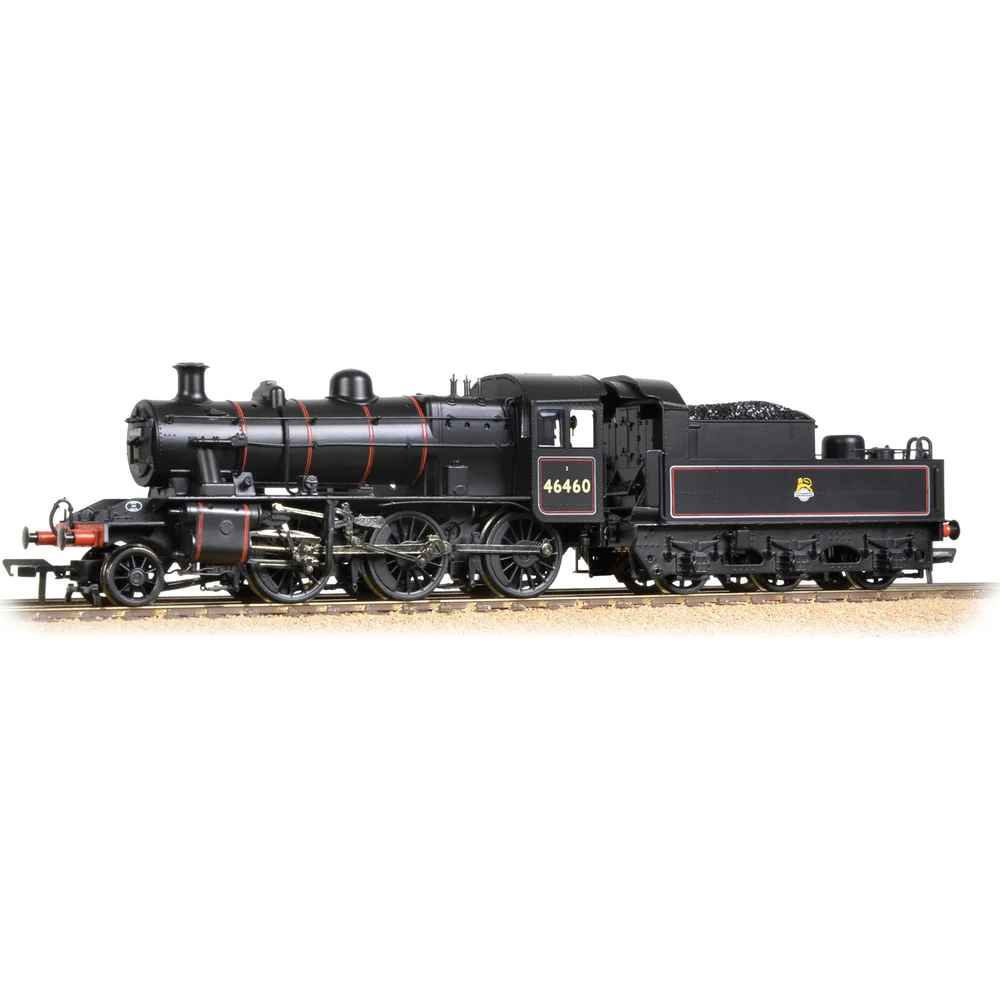Bachmann 32-826A
London, Midland & Scottish Railway Ivatt Class 2 2-6-0 46460 British Railways Lined Black with Early Emblem
Tooling
The Bachmann Branchline LMS Ivatt Class 2MT 2-6-0 was first introduced in 2007 as part of Bachmann’s OO gauge range. Designed to represent the post-war mixed-traffic moguls developed by H.G. Ivatt for the LMS, the model filled a gap in the market for a reliable and well-detailed representation of this versatile locomotive class. The tooling has since been used across multiple liveries and configurations, including special editions for the Bachmann Collectors Club.
Tooling Features
- Scale: OO gauge (1:76)
- Construction: Injection-moulded plastic body with separately fitted metal and plastic details
- Detailing: Flush glazing, separately fitted handrails, lamp irons, rivet detail, sprung metal buffers, and fine cab detailing
- Couplings: NEM pockets with tension lock couplings
Mechanical & Electrical
- Motor: Three-pole motor
- Drive: Loco-drive mechanism with drive to centre driving wheels
- Minimum Radius: Second radius curves (approx. 10.5 inches / 260 mm)
- Weighting: Moderate weight for reliable traction; some models include traction tyres
- Lighting: No factory-fitted lighting
DCC Capability
- OO Gauge: DCC Ready with 8-pin socket located in the tender
- Issues: Early OO models lacked tender pickups, affecting electrical reliability
Liveries Produced
- LMS Black
- BR Plain Black
- BR Lined Black (Early & Late Crest)
- BR Lined Green (Early & Late Crest)
- BR Maroon (Preservation-era special)
Reviews & Commentary
- Praised for high-quality detailing and accurate liveries
- Criticised for noisy motor and lack of tender pickups in early releases
- Collectors Club and SOUND FITTED editions received positively for enhanced features
- Social media and YouTube reviews (e.g., Sam’s Trains) highlight visual appeal and running performance
Interesting Notes
- Preserved locomotive No. 46521 featured in the BBC sitcom Oh, Doctor Beeching!
- Brassmasters and other aftermarket suppliers offer chassis kits for finescale conversions
The Bachmann Ivatt Class 2MT tooling remains a popular choice for modellers seeking a reliable and well-detailed representation of this iconic mixed-traffic locomotive. Its continued presence in OO gauge ranges reflects its enduring appeal and versatility.
Class & Prototype
- Class: London, Midland & Scottish Railway Ivatt Class 2 2-6-0
- Traction: Steam
- Built: 1946-1953
- Total Built: 128
- Running Number: 46460
Operator & Livery
- Operator: British Railways
- Livery: Lined Black with Early Emblem
- Era: 4 - British Railways Early Emblem
British Railways transformed Britain's fragmented rail network into a unified national system following nationalisation on 1st January 1948. Created from the "Big Four" companies under the Transport Act 1947, BR operated most of Great Britain's railways until rebranding as British Rail in 1965, managing over 20,000 route miles and inheriting nearly 20,000 locomotives of diverse designs.
The organisation pioneered standardisation through its revolutionary BR Standard locomotive programme (1951-1960), producing 999 advanced steam engines under Robert Riddles' direction. These included the versatile Britannia Pacifics, mighty 9F freight engines, and mixed-traffic classes that incorporated the best features from all predecessor companies. The 1955 Modernisation Plan accelerated diesel and electric traction development, creating fascinating mixed-traction operations.
Notable achievements included establishing unified locomotive classification systems, introducing distinctive corporate liveries, and managing the complex transition from steam to modern traction. BR's six regional structure preserved operational diversity whilst enabling standardisation of practices, signalling, and rolling stock that had eluded private enterprise for over a century.
The BR era represents steam traction's final flowering alongside emerging diesel technology, creating unparalleled locomotive variety. Today, this heritage remains highly popular with railway enthusiasts through extensive preserved fleets, heritage railway operations, and comprehensive model ranges from manufacturers like Hornby, Bachmann, and Dapol, making BR subjects essential for authentic post-war British railway modelling across all scales.
British Railways' lined black livery was designated for mixed-traffic and secondary passenger locomotives from 1949, following pure LNWR style with black base colour and elaborate red, cream (off-white), and grey lining patterns. The lining specification comprised 5/8" grey, 1/8" cream, 1½" black, and ¼" red bands, with the layout consistent with LNWR practice including deep and shallow valances lined along bottom edges only, unlike green engines. The first lined black engines appeared in August 1948 when Hall 5954 appeared so painted, becoming one of the first to carry the "Lion and Wheel" emblem around the same time.
A wide range of engines was eligible for this livery, from powerful V2s and Counties down to tiny Southern Terriers, encompassing County, Hall, Grange, Manor, Saint, Prairie tanks, and numerous pre-grouping designs of varied shapes and sizes. This created many variations and interpretation problems due to the diverse locomotive types involved, with regional differences in splasher lining treatment—the Eastern Region used red-only splasher lining, whilst the Southern Region evolved from inset to edge lining styles. The emblem was positioned centrally on tender sides above the middle axle box, with the Western Region favouring larger sizes on tenders and bigger tank engines. An interesting period detail saw number plates routinely painted red from late 1949 to early 1952, adding colour contrast to the otherwise black scheme. This livery represented BR's commitment to standardising mixed-traffic operations whilst maintaining the decorative traditions that distinguished passenger-rated locomotives from plain freight engines.
